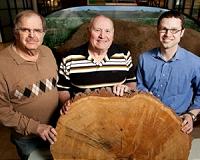| . |  |
. |
Anaheim CA (SPX) Mar 30, 2011 A curtain of flame halts firefighters trying to rescue a family inside a burning home. One with a special backpack steps to the front, points a wand at the flame, and shoots a beam of electricity that opens a path through the flame for the others to pass and lead the family to safety. Scientists described a discovery that could underpin a new genre of fire-fighting devices, including sprinkler systems that suppress fires not with water, but with zaps of electric current, without soaking and irreparably damaging the contents of a home, business, or other structure. Reporting at the 241st National Meeting and Exposition of the American Chemical Society (ACS), Ludovico Cademartiri, Ph.D., and his colleagues in the group of George M. Whitesides, Ph.D., at Harvard University, picked up on a 200-year-old observation that electricity can affect the shape of flames, making flames bend, twist, turn, flicker, and even snuffing them out. However, precious little research had been done over the years on the phenomenon. "Controlling fires is an enormously difficult challenge," said Cademartiri, who reported on the research. "Our research has shown that by applying large electric fields we can suppress flames very rapidly. We're very excited about the results of this relatively unexplored area of research." Firefighters currently use water, foam, powder and other substances to extinguish flames. The new technology could allow them to put out fires remotely - without delivering material to the flame - and suppress fires from a distance. The technology could also save water and avoid the use of fire-fighting materials that could potentially harm the environment, the scientists suggest. In the new study, they connected a powerful electrical amplifier to a wand-like probe and used the device to shoot beams of electricity at an open flame more than a foot high. Almost instantly, the flame was snuffed out. Much to their fascination, it worked time and again. The device consisted of a 600-watt amplifier, or about the same power as a high-end car stereo system. However, Cademartiri believes that a power source with only a tenth of this wattage could have similar flame-suppressing effect. That could be a boon to firefighters, since it would enable use of portable flame-tamer devices, which perhaps could be hand-carried or fit into a backpack. But how does it work? Cademartiri acknowledged that the phenomenon is complex with several effects occurring simultaneously. Among these effects, it appears that carbon particles, or soot, generated in the flame are key for its response to electric fields. Soot particles can easily become charged. The charged particles respond to the electric field, affecting the stability of flames, he said. "Combustion is first and foremost a chemical reaction - arguably one of the most important - but it's been somewhat neglected by most of the chemical community," said Cademartiri. "We're trying to get a more complete picture of this very complex interaction." Cademartiri envisions that futuristic electrical devices based on the phenomenon could be fixed on the ceilings of buildings or ships, similar to stationary water sprinklers now in use. Alternatively, firefighters might carry the flame-tamer in the form of a backpack and distribute the electricity to fires using a handheld wand. Such a device could be used, for instance, to make a path for firefighters to enter a fire or create an escape path for people to exit, he said. The system shows particular promise for fighting fires in enclosed quarters, such as armored trucks, planes, and submarines. Large forest fires, which spread over much larger areas, are not as suitable for the technique, he noted. Cademartiri also reported how he and his colleagues found that electrical waves can control the heat and distribution of flames. As a result, the technology could potentially improve the efficiency of a wide variety of technologies that involve controlled combustion, including automobile engines, power plants, and welding and cutting torches, he said.
Share This Article With Planet Earth
Related Links American Chemical Society Forest and Wild Fires - News, Science and Technology
 Old-Growth Tree Stumps Tell The Story Of Fire In The Upper Midwest
Old-Growth Tree Stumps Tell The Story Of Fire In The Upper MidwestChampaign IL (SPX) Mar 15, 2011 Researchers have constructed a 226-year history of fire in southern Illinois by looking at fire scars in tree stumps. Their study, the most in-depth fire history reported for the upper Midwest, reveals that changes in the frequency of fires dating back to the time of early European settlement permanently altered the ecology of the region. The researchers took advantage of a 1996 timber har ... read more |
|
| The content herein, unless otherwise known to be public domain, are Copyright 1995-2010 - SpaceDaily. AFP and UPI Wire Stories are copyright Agence France-Presse and United Press International. ESA Portal Reports are copyright European Space Agency. All NASA sourced material is public domain. Additional copyrights may apply in whole or part to other bona fide parties. Advertising does not imply endorsement,agreement or approval of any opinions, statements or information provided by SpaceDaily on any Web page published or hosted by SpaceDaily. Privacy Statement |